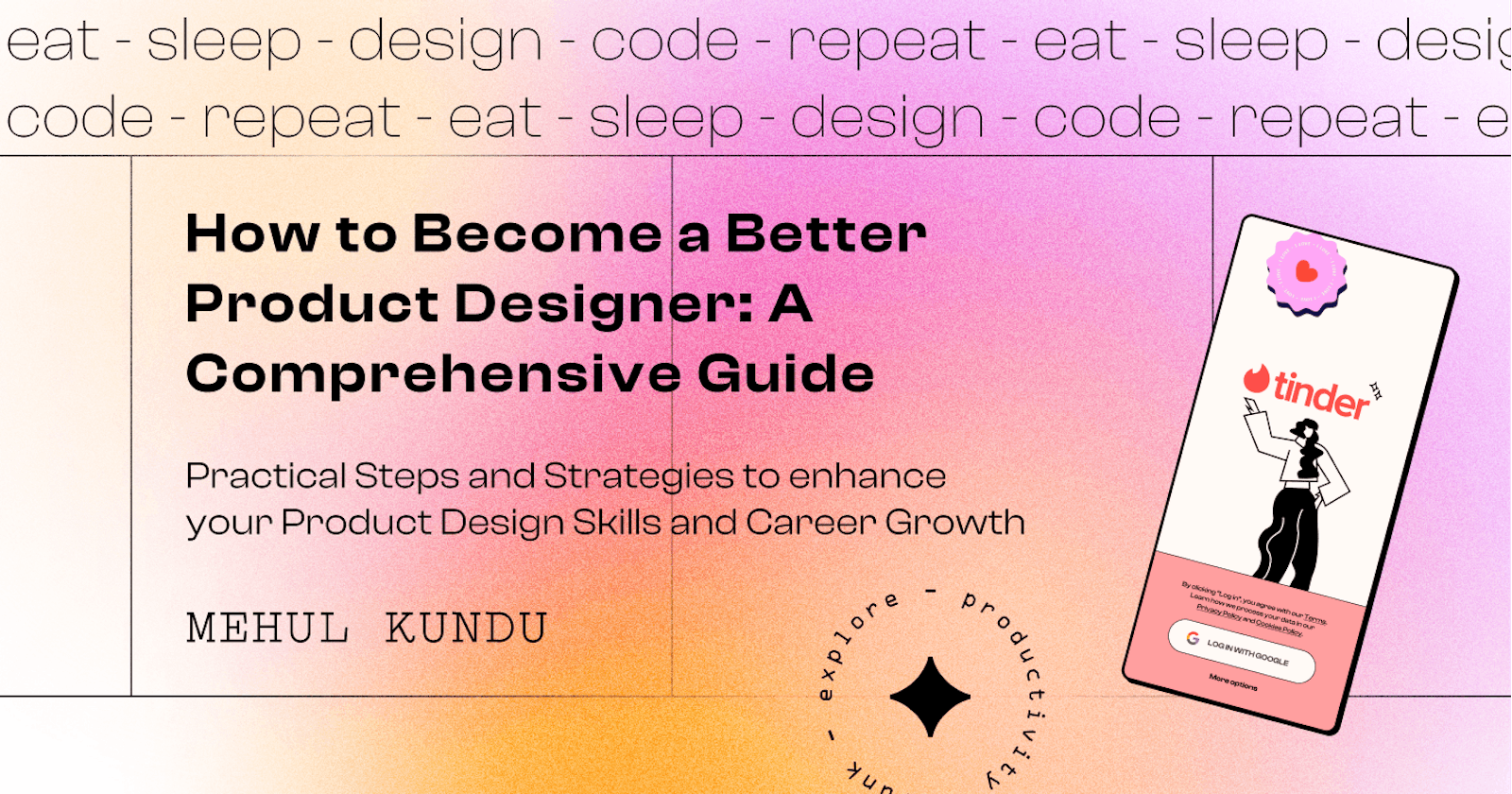How to Become a Better Product Designer: A Comprehensive Guide
Practical Steps and Strategies to enhance your Product Design Skills and Career Growth
Table of contents
- 1. Build a strong foundation in design principles
- 2. Master essential design tools
- 3. Learn the basics of UX/UI design
- 4. Enhance your skills in user research
- 5. Develop your problem-solving abilities
- 6. Embrace collaboration and communication
- 7. Stay up-to-date with industry trends
- 8. Build an impressive proof of works
- 9. Seek mentorship and network
- 10. Practice, practice, practice
- Conclusion
As a self-learned product designer, my learning journey was full of ups and downs. I got stuck in the tutorial hell of YouTube often. My learning journey is not linear, so whenever someone who's starting in design asks me how to learn design, the first thing I always tell them is not to follow my pathway for sure. So here I have prepared an ideal pathway for any beginner.
Product design is a multifaceted discipline that involves the creation and improvement of products to meet user needs and deliver delightful experiences. To excel in this field, one must possess a combination of technical skills, creativity, empathy, and a constant hunger for learning. In this blog post, we'll explore some actionable steps to help you become a better product designer.
1. Build a strong foundation in design principles
I can't emphasize it enough. I have seen many experienced designers sometimes while dealing with overly complicated requirements, forget to follow the basic rules of design. To become a skilled product designer, it's essential to understand the fundamental principles of design. These principles include:
Balance
Proximity
Alignment
Repetition
Contrast
White space
Hierarchy
Here is a YouTube playlist that will help you to learn the basics
Study these principles and practice applying them in your designs. Familiarize yourself with popular design systems, such as Material Design by Google and Apple's Human Interface Guidelines. Now keep in mind that understanding Material Design, or Apple's HIG, is intermediate level. So don't get upset if it feels difficult. Rather, I would suggest starting with a smaller design system. One great example will be "Untitled UI."
2. Master essential design tools
Being proficient in industry-standard design tools can help you create and communicate your ideas more effectively. Some popular tools include:
Figma:
The industry leader. In some of the job descriptions, you'll see Figma is one of the primary job requirements. Some people like me eventually use it for any design job, may it be for print or digital publication.
Adobe XD:
For me, XD comes second. Though it is mostly personal preference. Like Figma, it is also considered to be compulsory in job requirements. But as Adobe bought Figma maybe in the future we may experience both of the products merging.
Sketch:
It has been in the industry for a long time now. It is Mac only. Can't provide much overview about it.
Lunacy:
You can say Icons8 Lunacy is Sketch's alternative for Windows, though this is available on all of the major platforms. But it uses your Sketch Cloud account to sync your data. It is a new tool, so it has not yet matured completely, but it is free to use.
Origami Studio 3:
This is a product developed by Meta for their use. So like all other Meta products, it is free. Though not many designers use it or know about it, it is the MOST POWERFUL tool when it comes to prototyping. But it is also Mac-only.
Choose a tool that best suits your needs and invest time in learning its features and capabilities. Being versatile and knowledgeable about different tools is good. I would highly suggest mastering one tool first, that would be your go-to tool of choice.
3. Learn the basics of UX/UI design
Product design is a blend of user experience (UX) and user interface (UI) design. To create successful products, you need to understand how to create intuitive, user-friendly interfaces that also look visually appealing. Study UX principles, such as:
Usability
Consistency
Feedback
Flexibility
Error prevention
There are many other UX laws and psychological phenomena related to design that exists. To gain a deeper understanding, use the following resources:
Focus on UI design elements such as typography, color, and iconography. Learn to balance aesthetics with usability. Most of the basics of UI will already be covered in "foundation in design principles" above, and this is evergreen knowledge; never underestimate it. After that, just follow the current trend and try to recreate it.
4. Enhance your skills in user research
User research is crucial for understanding the needs, desires, and pain points of your target audience. Sometimes the product owners are not sure who their target audience is. I would highly suggest that you never work with any company like this. Because even as a UX researcher, it is not your job to find a targeted audience. Our job begins once there is a defined group of people, and after that, we consider other vertical or horizontal user personas as the product evolves. We make products for people, not vice-versa. A well-designed product is always "user-centric" or "user-oriented." So before making a product, have a clear understanding of for whom you're making it and optimize it for that set of people. By conducting user interviews, surveys, and usability tests, you can gather valuable insights that inform your design decisions. Familiarize yourself with various user research methods and learn to analyze and synthesize the data you collect.
5. Develop your problem-solving abilities
Product design is about solving problems for users. If you think deeply, it feels as if we are studying a portion of human psychology. Believe me when I say that the difficult task is to make a "simple product". Good UX always goes unnoticed because it is so natural to the user's behavioral pattern. That also means it might happen that you won't be celebrated as a remarkable UX designer for the same reasons explained in the previous line. But to be honest, that was our goal, to begin with. Learn to think critically and analytically about the challenges your users face and identify opportunities for improvement. Practice breaking down complex problems into smaller, manageable pieces and iterating on your designs to find the best solutions.
6. Embrace collaboration and communication
Product designers work closely with cross-functional teams, including developers, product managers, and marketers. Develop strong collaboration and communication skills to ensure your design ideas are understood and implemented effectively. Learn to give and receive constructive feedback to improve your designs and grow as a professional. To be honest, irrespective of your profession, communication is the key. You may be a genius inside, but no one will know if you're unable to express that. Even right now, by writing this blog, I'm communicating my thoughts and opinions. I'm able to express myself.
7. Stay up-to-date with industry trends
The world of product design is constantly evolving. Stay informed about the latest design trends, technologies, and best practices to stay competitive in the field. Follow influential designers on social media, read design blogs, and attend conferences and workshops to continue learning and expanding your skillset. But never forget the basics. This is the third time I'm repeating the same sentence.
8. Build an impressive proof of works
If I just say, "Hey, I'm Mehul, and I'm a great designer," will I get any clients or jobs? I have to show them what I can do, right? because work speaks louder than words. Even if right now you're reading this blog, you might have considered asking yourself at least once, "Who's this fellow blurbing so much?" or, if you know me, you may have already taken a look at my work, which is why you're here. So certainly it is more result-driven than flattering words.
A well-curated portfolio is a powerful tool for showcasing your skills, experience, and design process. Include a mix of personal projects, client work, and case studies to demonstrate your versatility and ability to solve real-world design problems. Here is my choice of portfolio tool which focuses purely on Proof of Works -
9. Seek mentorship and network
Connect with experienced product designers who can offer guidance, advice, and support as you navigate your career. Attend networking events, join online communities, or find a mentor through a mentorship program. You can try out many platforms and design communities. I'll list them here or make a separate blog about them later.
10. Practice, practice, practice
You can learn as much as you want, but if you don't apply it to projects, if you don't create designs, the net outcome will be zero. Becoming a better product designer takes time, dedication, and practice. Continue to work on personal projects, participate in design challenges, and seek opportunities to apply your skills in real-world situations.
In conclusion, becoming a better product designer involves mastering design principles, learning essential tools, honing your UX/UI design skills, and developing your problem-solving abilities. By following these steps and committing to continuous growth, you'll be well on your way to a successful career in product design.
Conclusion
In the future, I'll be publishing more blogs related to this topic and hyperlinking them in this blog so you can get a more detailed overview of each section discussed over here. This is just the main layout for you to have the primary push to kick-start yourself as a designer. If someone says designing is an easy job tell them to contact me, I would need their help making my Figma prototypes (just kidding 😂)
Here's my website; feel free to visit it for more content and my social media links. Drop me DMs if you need any help; I always try to answer them all.
Adios 👋🏼

